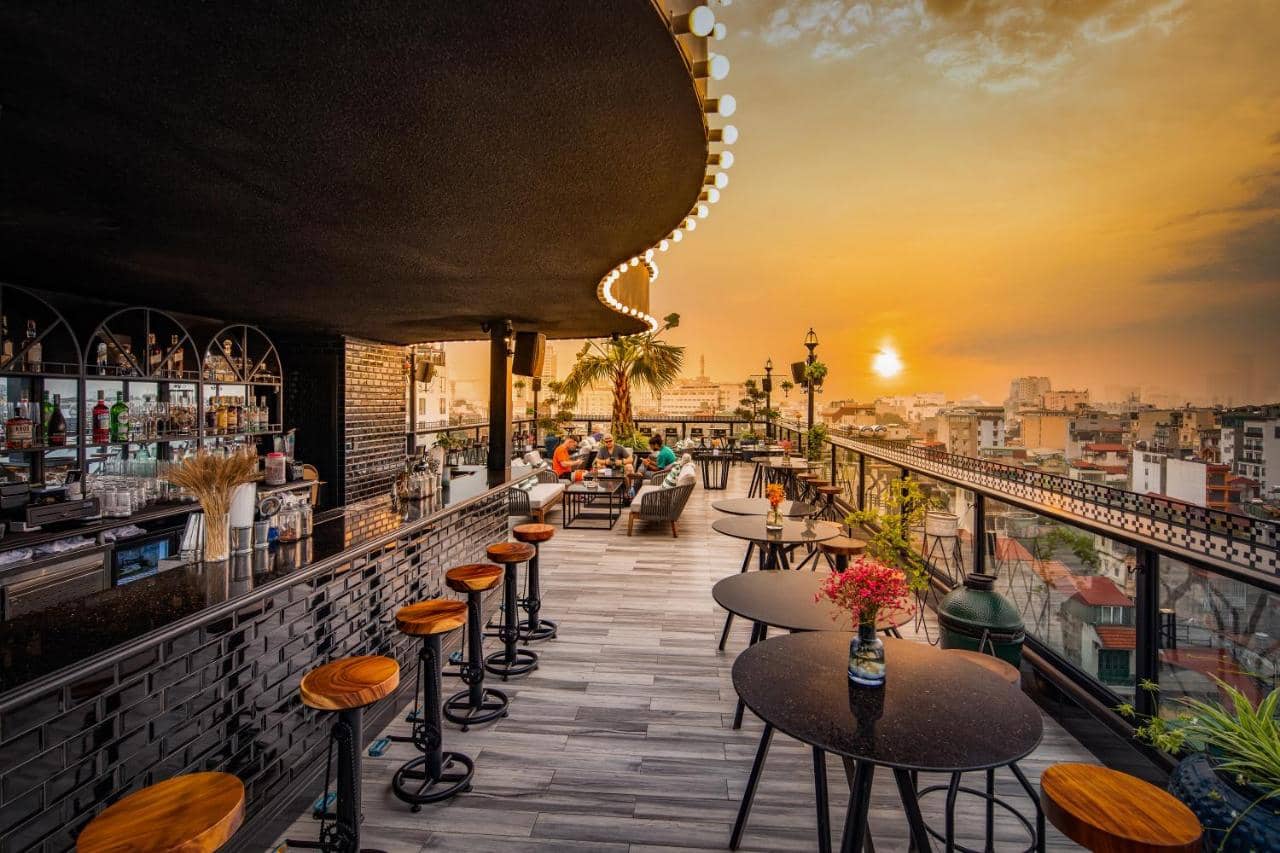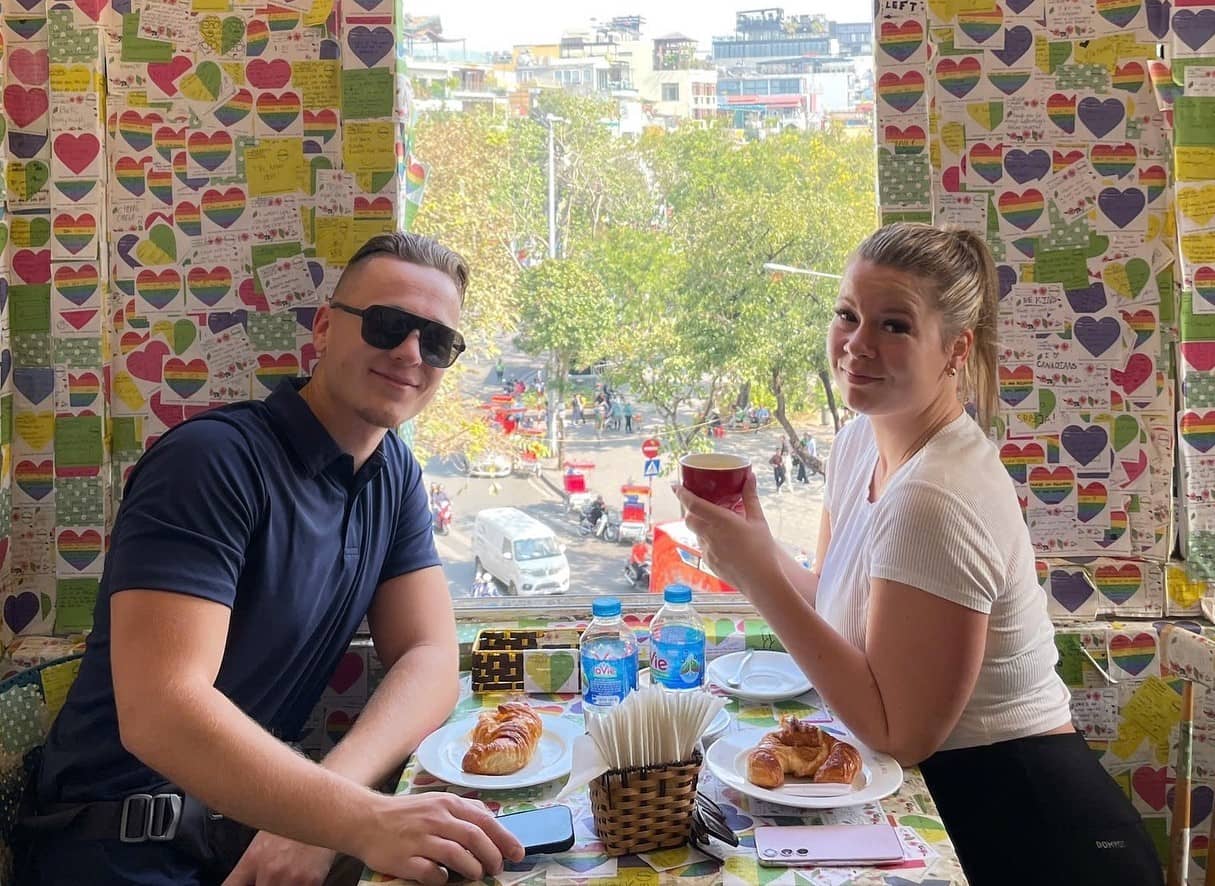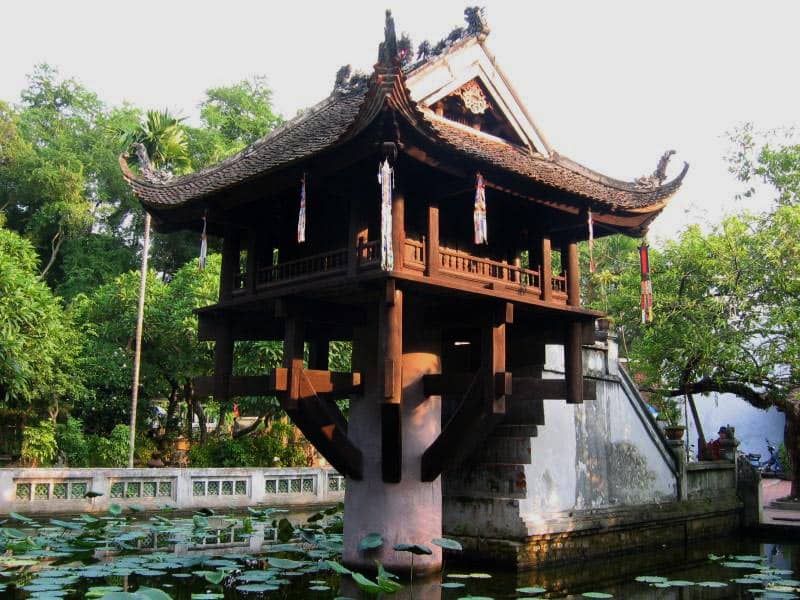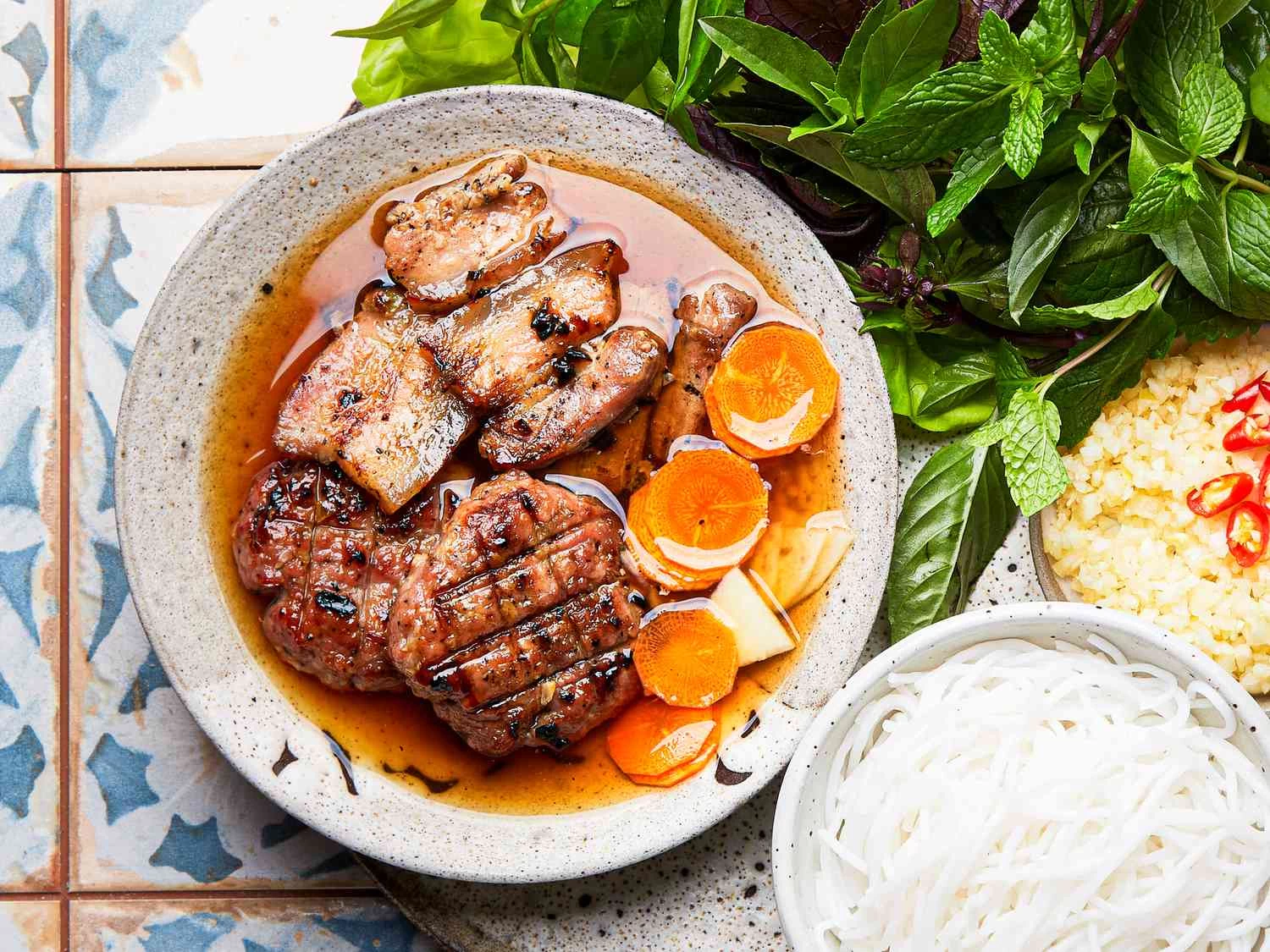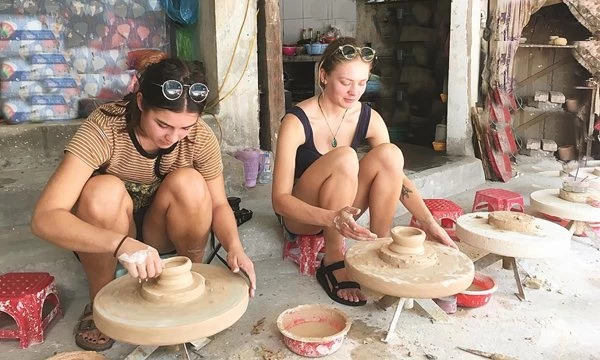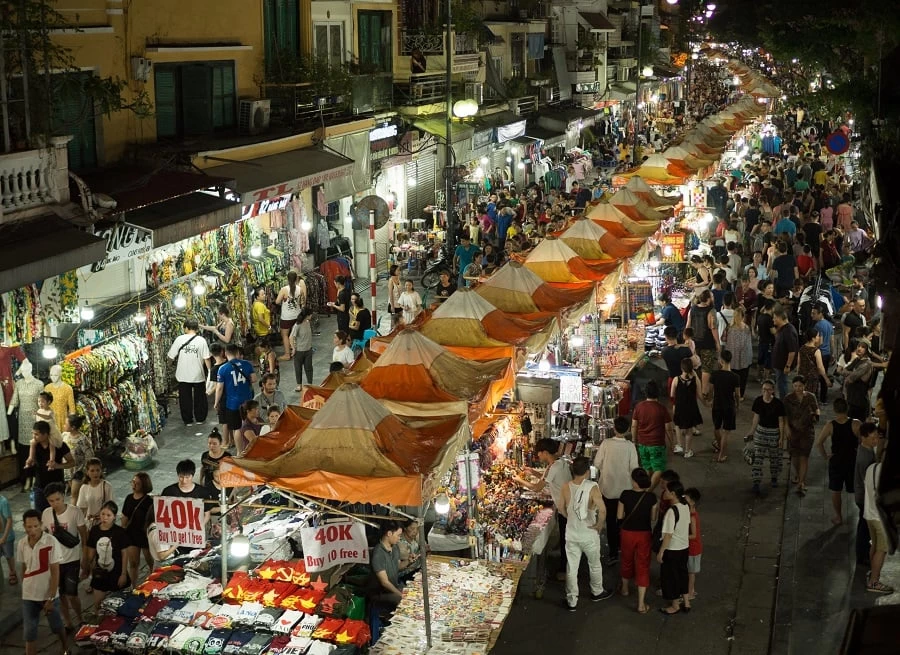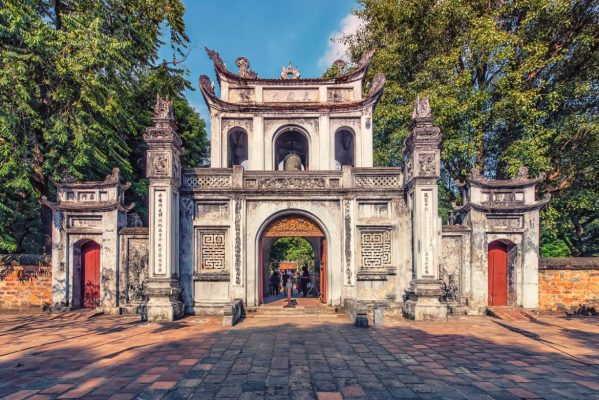
The Temple of Literature
Not just a famous cultural landmark, the Temple of Literature, is also one of Hanoi’s most captivating tourist attractions, with its unique architecture and tranquil ambiance drawing thousands of tourists each year. Built in the 10th century, the Temple of Literature, Vietnam’s first university, has become a must-visit destination in Hanoi. Here, visitors can learn about the history, cultural traditions of the Vietnamese people, and admire the unique beauty of the architectural structures.
I. HISTORY OF THE TEMPLE OF LITERATURE
The historical site of the Temple of Literature was established in the year 1070, during the reign of King Ly Thanh Tong. Initially, it was built by the king as a place to worship and pay tribute to the Confucian sages and teachers. Later, the king transformed it into a school for the royal family or the children of high-ranking officials in the court.
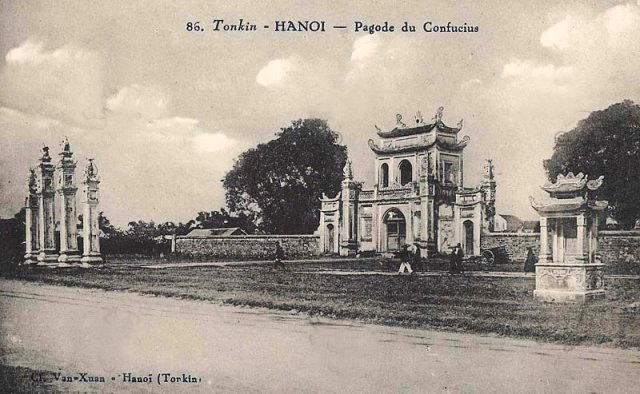
Images of the Temple of Literature in history
In 1976, King Ly Nhan Tong established the Temple of Literature as Quoc Tu Giam, making it the first university in Vietnam. However, at that time, only the royal descendants or the children of prominent officials could study there.
Over time, the role of the Temple of Literature expanded, becoming a place of study for talented commoners who excelled in their studies and passed the examinations organized by the court. The National Academy was established in 1253 by King Tran Thai Tong, marking the development of educational training functions at the Temple of Literature.
During the reign of King Tran Minh Tong, Chu Van An was appointed as the Chief Scholar of the Temple of Literature, equivalent to today’s principal, to directly educate the princes. However, Chu Van An passed away in 1370. He was honored by King Tran Nghe Tong with the construction of a tomb and a place of worship at the Temple of Literature, where he rested alongside Confucius.
In the reign of King Le Thanh Tong (1483), book printing was developed, and the names of successful scholars were inscribed on stone tablets starting from 1442, with each exam class having its own tablet. In the reign of King Le Hien Tong (1779), there were still 116 stone tablets on the backs of stone tortoises. In 1802, the Nguyen Dynasty built the Khue Van Pavilion for Confucian scholars to compose poetry and literary criticism.
In 1999, to commemorate the 990th anniversary of Thang Long – Hanoi (1010-2000), the Vietnamese government rebuilt the Thái Học – Văn Miếu area in ancient architectural style, honoring kings such as Ly Thanh Tong, Ly Nhan Tong, Le Thanh Tong, and the educator Chu Van An, who contributed significantly to preserving and developing Confucianism in the country’s first university.
II. WHERE IS THE TEMPLE OF LITERATURE LOCATED?
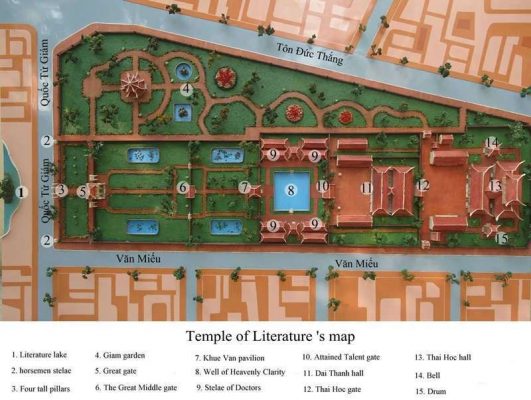
Temple of Literature map
the Temple of Literature, or Van Mieu Quoc Tu Giam, is located right in the heart of Hanoi, amidst the intersection of four streets: Nguyen Thai Hoc, Ton Duc Thang, Van Mieu, and Quoc Tu Giam. The specific address is 58 Quoc Tu Giam, Dong Da, Hanoi.
Getting to the Temple of Literature is quite convenient and easy. From Hoan Kiem Lake, you can head towards Le Thai To Street, turn right onto Trang Thi, then Cua Nam, Nguyen Khuyen, and finally turn left onto Van Mieu Street.
However, there are many one-way streets around the area of the Temple of Literature. To avoid complications during your journey, it’s advisable to plan your route in advance to save time.
III. HOW TO GET TO THE TEMPLE OF LITERATURE
Bus: If you prefer using the bus, you can choose from routes 02, 23, 38, 25, or 41 to get off at the nearest bus stop and then walk to the Temple of Literature.
Taxi or motorbike taxi (xe om): If you want to travel quickly and conveniently, taxi or motorbike taxi services are a good option. With the popularity of taxi and motorbike taxi services in Hanoi, you can easily find and book a ride to visit and explore the Temple of Literature. However, to avoid security risks and ensure reasonable prices, it’s important to choose reputable and reliable services.
Double-decker bus: This is a relatively new transportation option that has emerged in recent years. Exploring the Temple of Literature and other famous landmarks and historical sites in Hanoi by double-decker bus will provide you with a truly interesting experience.
Personal vehicle: Traveling by personal vehicle allows you to be more flexible with your time and explore many other destinations on the Hanoi tourist map. To find the most suitable route and avoid one-way streets or traffic jams, it’s recommended to study and consult maps or ask local residents for advice.
IV. ARCHITECTURE CHARACTERISTICS OF THE TEMPLE OF LITERATURE
The Temple of Literature is an impressive architectural complex built during the time of the Lý dynasty. With a rich history and unique ancient architecture, the Temple of Literature is considered one of the special heritages of the nation. This historical site is also one of the most famous tourist attractions in Hanoi, beloved by visitors from far and wide.
Similar to many other constructions, the Temple of Literature has undergone various dynasties, experiencing prosperity, decline, and numerous renovations and name changes to reach its current architectural position and space. It is not only a historical testimony but also a cultural symbol of Vietnam.
1. Incorporating Confucian and Buddhist architectural elements
The architectural style of the Temple of Literature reflects the profound influence of Confucianism and Buddhism in every detail of the space. From materials (mainly ironwood, fired bricks, and curved tiles) to intricate patterns, everything is meticulously and elegantly decorated.
2. Yin-Yang philosophy in architecture
The architecture of the Temple of Literature is deeply influenced by the Yin-Yang philosophy of Eastern beliefs. Like other Asian countries, Yin-Yang is an essential element of Feng Shui, a belief deeply ingrained in the Vietnamese subconscious for millennia.
Yin-Yang represents the harmony of heaven and earth, with human beings at the center, and the architecture of the Temple of Literature clearly demonstrates this concept.
The areas of the Temple of Literature are constructed along a central axis, symbolizing the convergence of heaven, earth, and humanity—the harmonization of heaven and earth at one point. This is the core of the Yin-Yang and Five Elements philosophy. Moreover, this philosophy encompasses even the smallest design details within this heritage site.
V. TOURIST ATTRACTIONS AT THE TEMPLE OF LITERATURE
1. Van Mieu Mon (Temple of Literature Gate)
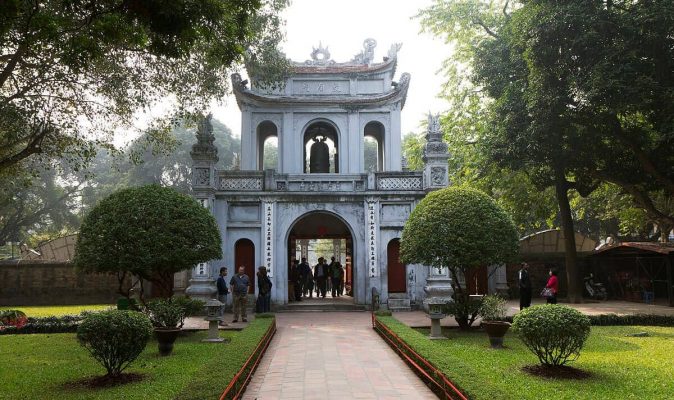
Van Mieu Mon of the Temple of Literature
The Tam Quan Gate, or Van Mieu Mon, is uniquely constructed with three doors, with the central door being two stories high, with the inscription “文廟門” (Temple of Literature Gate) on the upper floor.
This architectural style is a unique highlight in the study of ancient Vietnamese architecture. The three distinct structures outside the gate are prominent, especially the central entrance with its impressive design, featuring a larger lower level and a smaller upper level stacked in the middle of the lower floor.
In front of Van Mieu Mon of the Temple of Literature, there are four pillars with two stone steles, marking the boundary. In the past, anyone passing through the Temple of Literature, whether a nobleman or a commoner, had to dismount and walk from this stone stele. Only after passing the other stone stele were they allowed to mount their horse or vehicle.
The pillars are built of bricks, with the two central pillars taller and adorned with two kneeling nghê creatures, considered sacred objects with the ability to penetrate human thoughts. The two outer pillars are adorned with four phoenixes, creating a sacred and unique architectural structure.
2. Great Middle Gate
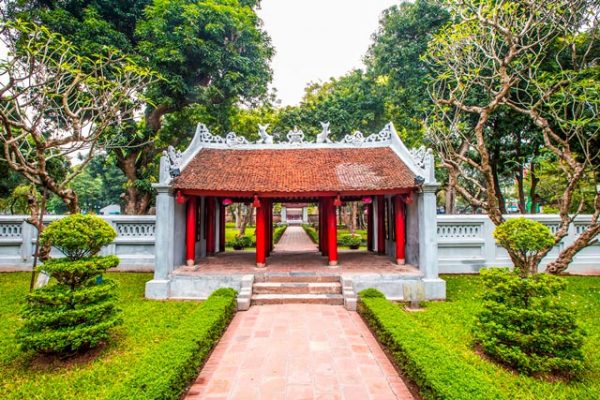
Great Middle Gate
Entering from the main gate of Van Mieu Mon leads to the first area, called the Entrance Path. Passing through the entrance path leads to the second area, known as the Great Middle Gate.
Previously, there were two gates, the left and right gates, in front, followed by the Great Middle Gate, Thanh Duc Mon, and Dai Tai Mon gates at the back. However, after being attacked by French troops in 1947, only two gates remain, surrounded by a peaceful atmosphere of grass and trees.
A horizontal wall connects the three doors, extending out on both sides to create a square courtyard enclosed by outer walls, with an opening at Van Mieu Mon. The serene and elegant scenery of the “literary world in the capital” is created by trees and two rectangular ponds along this courtyard.
3. Pavilion of Constellation Literature
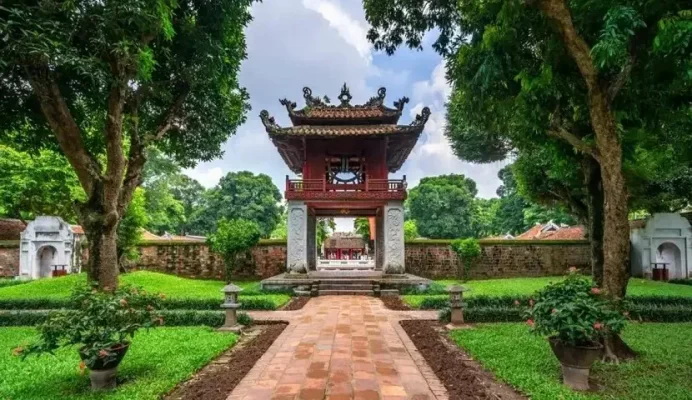
Pavilion of Constellation Literature
Pavilion of constellation literature, also known by the poetic name “admiring the beauty of the Khuê star,” is a unique architectural masterpiece built in 1805 during the Nguyen dynasty. Pavilion of constellation literature is built on a symmetric square base with Bat Trang brick, each side measuring 6.8 meters.
The design of Pavilion of constellation literature is a combination of harmony and uniqueness. The lower level features four square brick pillars, each measuring one meter, adorned with delicate patterns. The upper level is a wooden structure painted with gold lacquer, creating a graceful and impressive appearance.
The wooden floor of the pavilion is designed with two openings for stairs to the upper floor. Details such as carved wooden rims, wooden balustrades, and other decorative elements all reflect meticulousness and sophistication.
The four walls are covered with wooden panels, each with a beautiful round door, symbolizing the Khuê star and its rays of light. A small signboard with the words “Khuê Văn Các” in gold lacquer hangs in front of the door, enhancing the beauty of this place.
4. Doctoral Stele Pavilion at Thien Quang Well
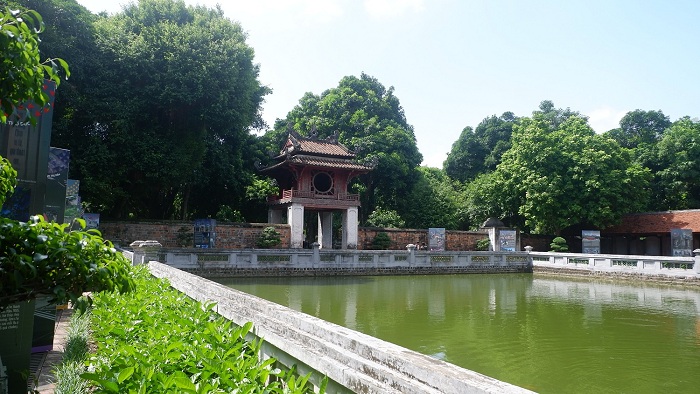
Thien Quang Well
Thien Quang Well, also known as Thien Quang Tinh, is considered an architectural masterpiece at the Temple of Literature. The well is designed with a unique square shape, surrounded by a railing. Therefore, Thien Quang Well is seen as a symbolic representation of the earth. Along with the round door of the Khuê Văn Các, it symbolizes the sky.
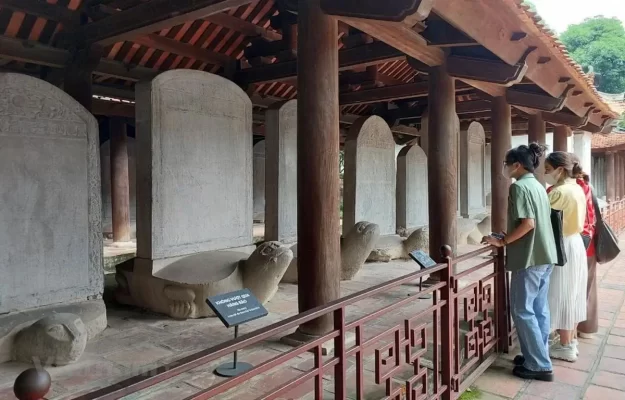
Doctoral Stele Pavilion
Amidst the elegant beauty of Thien Quang Tinh, there are 82 stone steles engraved with stories of the lives of outstanding scholars who passed their doctoral exams from 1484 to 1780. The special feature of Thien Quang Well lies in the stone turtle with a pedestal, which is a doctoral stele excavated in 1976.
5. Worship Area House at Great Success Gate
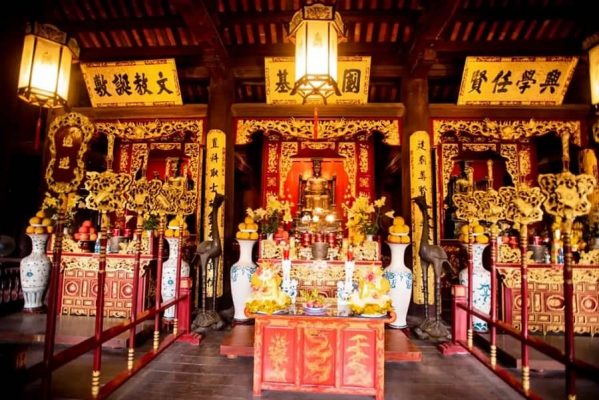
The worship area houses
Great success gate is a magnificent architectural structure, featuring traditional design elements with a profound ancient charm. It is composed of three large houses, covered with tiled roofs.
The distinctive feature of Great success gate is the two sturdy front columns, which embellish the solemnity and dignity of the place. Passing through Great success gate, one enters the Dai Bai Duong, also known as the worship area, a sacred and mystical space.
The worship area houses precious artifacts, from ancient paintings and incense burners to pairs of ancient cranes and a large bell cast in 1768. Dai Bai Duong is a sacred place used for organizing solemn ceremonies during the traditional spring festival.
6. Khai Thanh Temple
Located within the same complex as the Temple of Literature is the Khai Thanh temple, a historical site used to honor the two foster parents of Confucius, Thuc Luong Ngoc and Nhan Thi.
Khai Thanh temple has undergone many ups and downs in history. Previously, this place was a large residential area with over 150 rooms for scholars. Therefore, it symbolizes the prosperity of the nation and the presence of knowledge. However, in 1946, the French colonialists bombed the Khai Thanh temple, almost completely destroying it.
Later, with the efforts of the government, Khai Thanh temple regained some historical value and continues to exist to this day.
7. Front and Back Pavilions
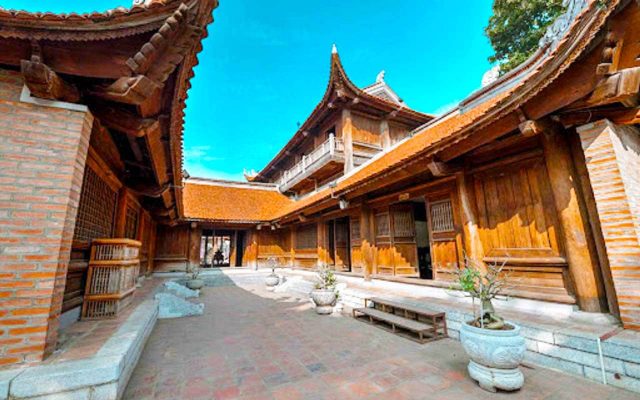
The front and back pavilion in the Temple of Literature
The Front and Back Pavilions are two entirely new architectural structures built by the state on July 13, 1999, to preserve the remaining precious artifacts at the Temple of Literature.
The front pavilion has nine rooms, with 40 rare ironwood columns reaching up to 7 meters in height. This area demonstrates the tradition of respecting teachers and venerating morality, as well as organizing large cultural and artistic activities.
The Back Pavilion features two-story architecture. The first floor has nine rooms with 72 ironwood columns. It is dedicated to honoring the national teacher Chu Van An and introducing the history of the Temple of Literature to visitors.
The second floor is used to worship eminent scholars and kings who contributed to the country’s education in the past, such as Kings Ly Thanh Tong, Ly Nhan Tong, and Le Thanh Tong, as well as other important figures in Confucianism.
VI. THINGS TO NOTE WHEN VISITING THE TEMPLE OF LITERATURE
When visiting the Temple of Literature, it’s important to adhere to the following guidelines to protect and respect the cultural heritage:
- Follow the regulations of the management board: Listen to the instructions of the security staff and adhere to the regulations of the heritage site, such as not bringing food, drinks, sharp objects, etc.
- Protect artifacts and landscapes: Be careful when moving around the heritage site to avoid touching artifacts and landscapes.
- Do not touch the turtle’s head, and avoid sitting on doctoral steles: The turtle’s head and doctoral steles are cultural symbols with special significance, so respect them and avoid touching them.
- Wear appropriate, neat clothing: Dress modestly and neatly to maintain the solemnity and dignity of the heritage site.
- Maintain order and refrain from using inappropriate language: Keep order and avoid causing disturbances, using civilized language to create a peaceful environment and respect for all other visitors.
- When burning incense, only use one incense stick: Burn incense properly, using only one incense stick, to avoid causing smoke and environmental pollution.
VII. TRAVEL TIPS FOR VISITORS WHEN TRAVELLING TO THE TEMPLE OF LITERATURE
Here are some travel tips for you to have a complete visit to the Temple of Literature:
- Learn about the history and culture of the heritage site beforehand. This will help you understand more about what you are seeing and experiencing.
- Arrive early to avoid crowds: The heritage site is usually crowded during holidays and Tet, so arrive early to be able to explore more comfortably.
- Bring water and a hat. The weather in Hanoi can be hot and humid, so bring water and a hat to avoid dehydration and sunburn.
- Opening hours for visiting the Temple of Literature in Hanoi:
- Summer season: April 15th to October 15th: open from 7:30 a.m. to 5:30 p.m..
- Winter season: October 16th to April 14th of the following year: open from 8:00 a.m. to 5:00 p.m..
The Temple of Literature is an attractive and worthwhile tourist destination. Please adhere to the regulations above to protect and respect this cultural heritage while having a complete and memorable visit.



